- Home
- About
- Map
- Trips
- Bringing Boat West
- Migration West
- Solo Motorcycle Ride
- Final Family XC Trip
- Colorado Rockies
- Graduates' XC Trip
- Yosemite & Nevada
- Colorado & Utah
- Best of Utah
- Southern Loop
- Pacific Northwest
- Northern Loop
- Los Angeles to NYC
- East Coast Trips
- Martha's Vineyard
- 1 Week in Quebec
- Southeast Coast
- NH Backpacking
- Martha's Vineyard
- Canadian Maritimes
- Ocracoke Island
- Edisto Island
- First Landing '02
- Hunting Island '02
- Stowe in Winter
- Hunting Island '01
- Lake Placid
- Chesapeake
- Provincetown
- Hunting Island '00
- Acadia in Winter
- Boston Suburbs
- Niagara Falls
- First Landing '99
- Cape Hatteras
- West Coast Trips
- Burning Man
- Utah Off-Roading
- Maui
- Mojave 4WD Course
- Colorado River Rafting
- Bishop & Death Valley
- Kauai
- Yosemite Fall
- Utah Off-Road
- Lost Coast
- Yosemite Valley
- Arizona and New Mexico
- Pescadero & Capitola
- Bishop & Death Valley
- San Diego, Anza Borrego, Joshua Tree
- Carmel
- Death Valley in Fall
- Yosemite in the Fall
- Pacific Northwest
- Utah Off-Roading
- Southern CA Deserts
- Yosemite & Covid
- Lake Powell Covid
- Eastern Sierra & Covid
- Bishop & Death Valley
- Central & SE Oregon
- Mojave Road
- Eastern Sierra
- Trinity Alps
- Tuolumne Meadows
- Lake Powell Boating
- Eastern Sierra
- Yosemite Winter
- Hawaii
- 4WD Eastern Sierra
- 4WD Death Valley +
- Southern CA Deserts
- Christmas in Tahoe
- Yosemite & Pinnacles
- Totality
- Yosemite & Sierra
- Yosemite Christmas
- Yosemite, San Diego
- Yosemite & North CA
- Seattle to Sierra
- Southwest Deserts
- Yosemite & Sierra
- Pacific Northwest
- Yosemite & South CA
- Pacific Northwest
- Northern California
- Southern Alaska
- Vancouver Island
- International Trips
- Index
- Tips
- Books
- Photos/Videos
- Search
- Contact
San Cristobal Island, Ecuador
Sunday, March 26, 2023 - 10:00pm by Lolo
0 miles and 0 hours from our last stop - 1 night stay
Travelogue
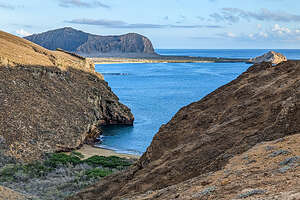 Hike up Punta PittThis was it. Our last full day in the Galapagos. Tomorrow we fly back to Quito and then home. It seemed like we had been here for a very long time, but still I didn’t want it to end.
Hike up Punta PittThis was it. Our last full day in the Galapagos. Tomorrow we fly back to Quito and then home. It seemed like we had been here for a very long time, but still I didn’t want it to end.
While we slept, our trusty captain moved us from Espanola to San Cristobal, the easternmost island in the archipelago and also the provincial capital. It was the site of the first human settlement in the Galapagos and the first island Charles Darwin visited in 1835.
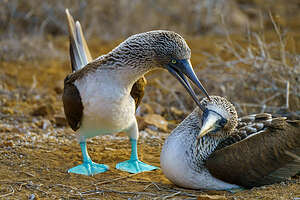 Blue-footed boobiesThe island was formed by four large shield volcanoes fused together by successive lava flows to form a single island.
Blue-footed boobiesThe island was formed by four large shield volcanoes fused together by successive lava flows to form a single island.
We began our day with an early morning wet landing on Punta Pitt, a volcanic tuff formation that serves as a nesting site for many sea birds - all three types of boobies, both types of frigatebirds, swallow-tailed gulls, and storm petrels.
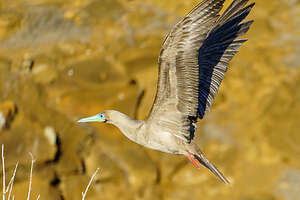 Red-footed booby in flightFrom the beach, it’s a fairly strenuous hike uphill (two hours round trip) to the top of tuff, where it flattens out into a beautiful landscape of tuff cones, colorful vegetation, panoramic views of the sea, and seabirds everywhere.
Red-footed booby in flightFrom the beach, it’s a fairly strenuous hike uphill (two hours round trip) to the top of tuff, where it flattens out into a beautiful landscape of tuff cones, colorful vegetation, panoramic views of the sea, and seabirds everywhere.
There were lovely views along the way and once on top the red vegetation and rocky cliffs over the sea were stunning.
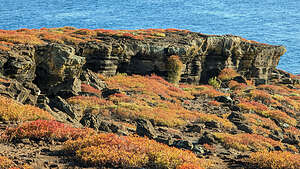 View from top of Punta PittIt is the only site in the Galapagos where you can see all three species of boobies (blue-footed, red-footed, and Nazca) and two species of frigatebirds (Magnificent and Great) nesting in the same area.
View from top of Punta PittIt is the only site in the Galapagos where you can see all three species of boobies (blue-footed, red-footed, and Nazca) and two species of frigatebirds (Magnificent and Great) nesting in the same area.
Since the boobies have very different nesting preferences - red-footed boobies nest in the bushes, Nazca boobies nest in the cliffs, and the blue-footed boobies in the middle of the trails - you won’t find them next to each other.
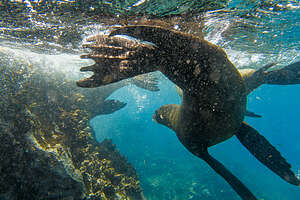 Snorkeling with the sea lionsAlso, since there is no competition between them for food, they get along just fine when they do meet, because they don’t have to compete to survive.
Snorkeling with the sea lionsAlso, since there is no competition between them for food, they get along just fine when they do meet, because they don’t have to compete to survive.
We came across our old friends (and my personal favorite), the blue-footed boobies, playfully, dancing, flirting, and nesting right in our path.
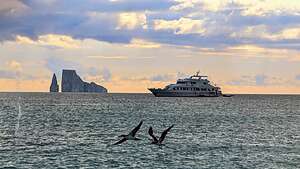 View of Kicker Rock from Cerro Brujo BeachThey have such personality and attitude that it’s hard not to anthropomorphize and think you know what they are thinking.
View of Kicker Rock from Cerro Brujo BeachThey have such personality and attitude that it’s hard not to anthropomorphize and think you know what they are thinking.
The red-footed boobies were much harder to find, because they nest in the bushes, and there is inevitably a branch or more blocking their cute little faces. Or, they were flying through the air, just close enough that we could detect their red feet.
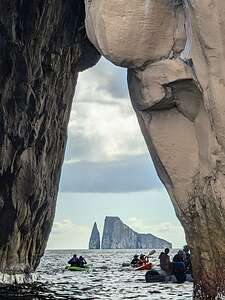 Cueva del BrujoWe found two out of the three species of boobies - the Nazca boobies were nowhere to be found. They build their nests in cliffs, so I have a feeling they were down near the beautiful volcanic cliffs overlooking the sea.
Cueva del BrujoWe found two out of the three species of boobies - the Nazca boobies were nowhere to be found. They build their nests in cliffs, so I have a feeling they were down near the beautiful volcanic cliffs overlooking the sea.
It was a lovely hike, one of the nicest we had done this trip.
Back on the Tip Top IV, we switched gears, donned our wetsuits and headed out on the pangas to hopefully snorkel with the sea lions, as Tui and Monica thought was a strong possibility.
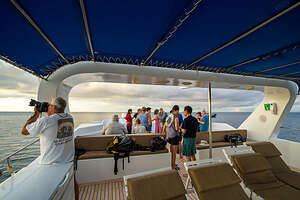 Farewell Party on the upper deckBoy, were they right. We spent an hour with literally dozens of sea lions doing acrobatics in the water, zipping between our legs, swimming upside down, and so many other entertaining things. It was crazy and so exhilarating!
Farewell Party on the upper deckBoy, were they right. We spent an hour with literally dozens of sea lions doing acrobatics in the water, zipping between our legs, swimming upside down, and so many other entertaining things. It was crazy and so exhilarating!
Later that afternoon we went for a panga ride to Cerro Brujo, a beautiful white coral sand beach and lagoon. It was one of the first sites visited by Charles Darwin in the 1830s.
From the beach, we had our first view of Kicker Rock, one of the Galapagos’s most iconic landmarks, and one of the things I most wanted to see. It is the remnants of a vertical tuff cone formation that rises 500 feet above the ocean. It is striking.
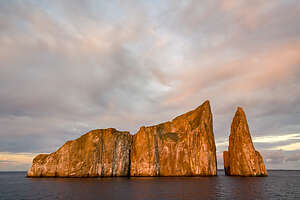 Circling Kicker RockThe sheer walled volcanic tuff cone has been eroded in half with a narrow channel in between, giving it its characteristic shape of a sleeping Lion (Leon Dormido).
Circling Kicker RockThe sheer walled volcanic tuff cone has been eroded in half with a narrow channel in between, giving it its characteristic shape of a sleeping Lion (Leon Dormido).
After strolling the beach for a while, we went back out in kayaks and the pangas to Cueva del Brujo, an arch through which there is a great view of Kicker Rock.
We also cruised into an inlet that ended with cliffs hundreds of feet high surrounding us on three sides.
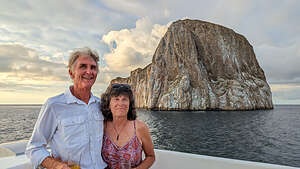 Happy CoupleIt was quite the day, but it wasn’t over yet. Tonight was the big farewell party back on the ship. Tui surprised us with a bottle of rum and some guava juice, which we thoroughly enjoyed on the upper deck, while the ship slowly circled Kicker Rock as the sun went down.
Happy CoupleIt was quite the day, but it wasn’t over yet. Tonight was the big farewell party back on the ship. Tui surprised us with a bottle of rum and some guava juice, which we thoroughly enjoyed on the upper deck, while the ship slowly circled Kicker Rock as the sun went down.
It was probably one of the most amazing sunsets of an entire trip full of amazing sunsets. The sky went from yellow and reds, to bright red, to orange all in a span of 45 minutes.
We laughed, we hugged, we took photos of each other. We had become quite the family over the last 10 days.
It was going to be tough going home tomorrow.
Recap of wildlife we saw today: Blue-footed boobies, red-footed boobies, sea lions
- ‹ previous
- 12 of 13
- next ›
San Cristobal Island location map in "high definition"
Javascript is required to view this map.
